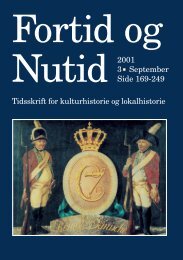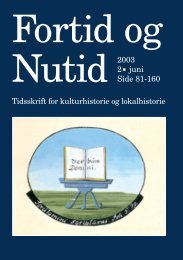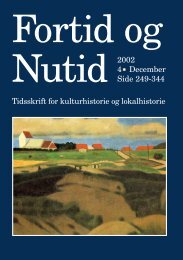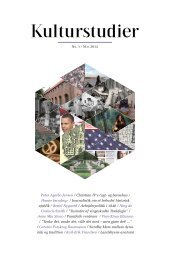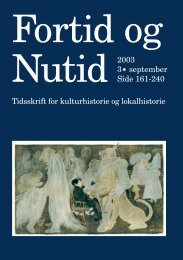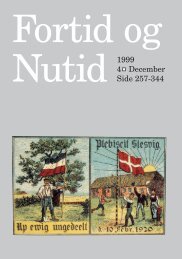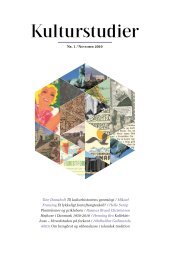Læs hele tidsskriftet (PDF) - Kulturstudier
Læs hele tidsskriftet (PDF) - Kulturstudier
Læs hele tidsskriftet (PDF) - Kulturstudier
Create successful ePaper yourself
Turn your PDF publications into a flip-book with our unique Google optimized e-Paper software.
<strong>Kulturstudier</strong> Nr. 2, 2011 The reconfigured body 10/15<br />
In 1998, the journal Nature had a thematic issue on xenotransplantation, and<br />
presented the scientific debate on the risks of the technology. Different resear-<br />
chers' points of view were presented:<br />
“Paul Herrling, scientific director of Novartis, says the Hong Kong flu outbreak<br />
shows “that the risk from other sources is much greater, and that the added<br />
risk in view of the life-saving nature of a successful xenotransplantation might<br />
be minimal”. Other researchers are less sanguine. “I take the same data and<br />
turn it around, saying ‘look, this can happen’”, says virologist Robin Weiss”.<br />
[…]<br />
“He argues that activation of animal viruses might be favoured under transplant<br />
conditions, as these remove many barriers to natural means of infection<br />
[…] “I’m not saying you shouldn’t do this [clinical trials of xenotransplantation],<br />
I’m asking you, ‘have you stopped to think’?”, says Weiss.” 31<br />
The discussions focused upon the questions whether there was a natural barrier<br />
between humans and animals, or if we, as humans, are interlocked in a network<br />
within which nature is seen as an intrinsic part, and are therefore exposed to<br />
the dangers of virus. Could there be barriers to natural means of infection that<br />
would be removed with xenotransplantation? Hong Kong flu, HIV and the connection<br />
between BSE (bovine spongiform encephalopathy), also called mad cow<br />
disease, and Creutzfeld Jacobs syndrome, were all serious diseases used in the<br />
media to show that animals had infected humans. However, in the article above<br />
these examples were used by both Herrling and Weiss, and in this way they represented<br />
opposite views.<br />
According to the media discussion, the pig became a dangerous object threatening<br />
humankind. While the biotechnological researchers tried to control the<br />
processes around xenotransplantation, the risk for retrovirus was an unforeseen<br />
and uncontrollable consequence for the researchers. 32 With an ANT perspective,<br />
as presented in the beginning of the article, it is possible to see how the researchers,<br />
as actors, could not fully control other actors such as the retrovirus. The retrovirus<br />
is, in the ANT analysis, seen as a nonhuman actor comprising an energy<br />
that might affect the outcome of the medical trials in different, and unexpected,<br />
ways. 33 In xenotransplantation other nonhuman actors affected the outcome, for<br />
example the problem of immunosuppression and cells, tissue or organs behaving<br />
in ways the researchers could not fully control. But the retrovirus was unique;<br />
it was an actor that contained a greater risk, as it was also able to infect a third<br />
party.<br />
31 Nature 22.01.1998, p. 321.<br />
32 Twine 2010.<br />
33 Goodman 2001.<br />
151



